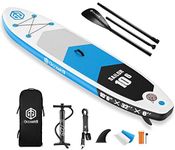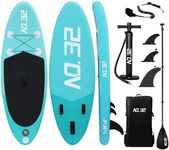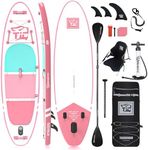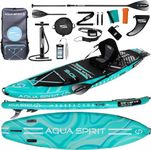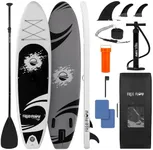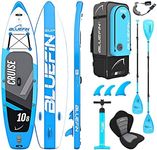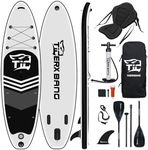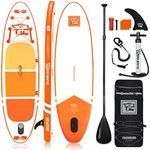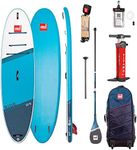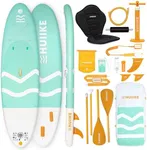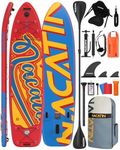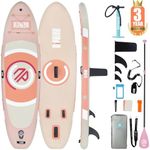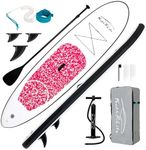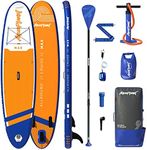Buying Guide for the Best Paddle Boards For Beginners
Choosing the right paddle board as a beginner can be a fun and rewarding experience. The key is to find a board that matches your skill level, body type, and the type of paddling you plan to do. By understanding the key specifications and how they affect performance, you can make an informed decision that will help you enjoy your time on the water and improve your skills more quickly.Board LengthThe length of a paddle board affects its speed, stability, and maneuverability. Shorter boards (under 10 feet) are more maneuverable and easier to turn, making them great for surfing or paddling in tight spaces. Medium-length boards (10-12 feet) offer a balance of speed and stability, ideal for all-around use. Longer boards (over 12 feet) are faster and track better, making them suitable for long-distance paddling or racing. As a beginner, a medium-length board is often the best choice as it provides a good balance of stability and versatility.
Board WidthThe width of a paddle board plays a crucial role in its stability. Wider boards (over 30 inches) are more stable and easier to balance on, which is important for beginners. However, they can be slower and less responsive. Narrower boards (under 30 inches) are faster and more agile but require better balance and skill. For beginners, a board width of 30-34 inches is typically recommended as it offers a good mix of stability and performance.
Board ThicknessThickness affects the volume and buoyancy of the paddle board. Thicker boards (over 5 inches) provide more buoyancy and can support more weight, making them more stable for beginners. Thinner boards (under 5 inches) are lighter and more responsive but may not offer the same level of stability. For beginners, a board thickness of 5-6 inches is generally ideal as it provides ample stability and support.
Board VolumeVolume is a measure of the board's buoyancy and is expressed in liters. Higher volume boards can support more weight and are more stable, which is beneficial for beginners. Lower volume boards are less buoyant and require better balance. To find the right volume, consider your weight and the type of paddling you plan to do. As a general rule, beginners should look for a board with a volume that is at least 1.5 times their body weight in kilograms.
Board ShapeThe shape of the paddle board affects its performance in different conditions. All-around boards have a rounded nose and tail, making them versatile and suitable for various activities like flatwater paddling, small waves, and yoga. Touring boards have a pointed nose and are designed for speed and long-distance paddling. Surfing boards are shorter with a more pronounced rocker (curvature) for better maneuverability in waves. As a beginner, an all-around board is usually the best choice as it offers versatility and ease of use in different conditions.
Construction MaterialPaddle boards can be made from different materials, each affecting the board's weight, durability, and performance. Inflatable boards are made from PVC and are lightweight, portable, and durable, making them a great option for beginners. Epoxy boards are made from foam and fiberglass, offering better performance and rigidity but can be more prone to damage. Soft-top boards have a foam deck for added comfort and safety, ideal for beginners and families. Consider your needs and how you plan to use the board when choosing the construction material.
Fin SetupThe fin setup on a paddle board affects its tracking and maneuverability. Single fin setups are common on all-around and touring boards, providing good tracking and stability. Three-fin (or thruster) setups are often found on surfing boards, offering better maneuverability in waves. Some boards have removable fins, allowing you to customize the setup based on your needs. For beginners, a single fin or 2+1 setup (one large center fin and two smaller side fins) is usually sufficient, providing a good balance of stability and tracking.
